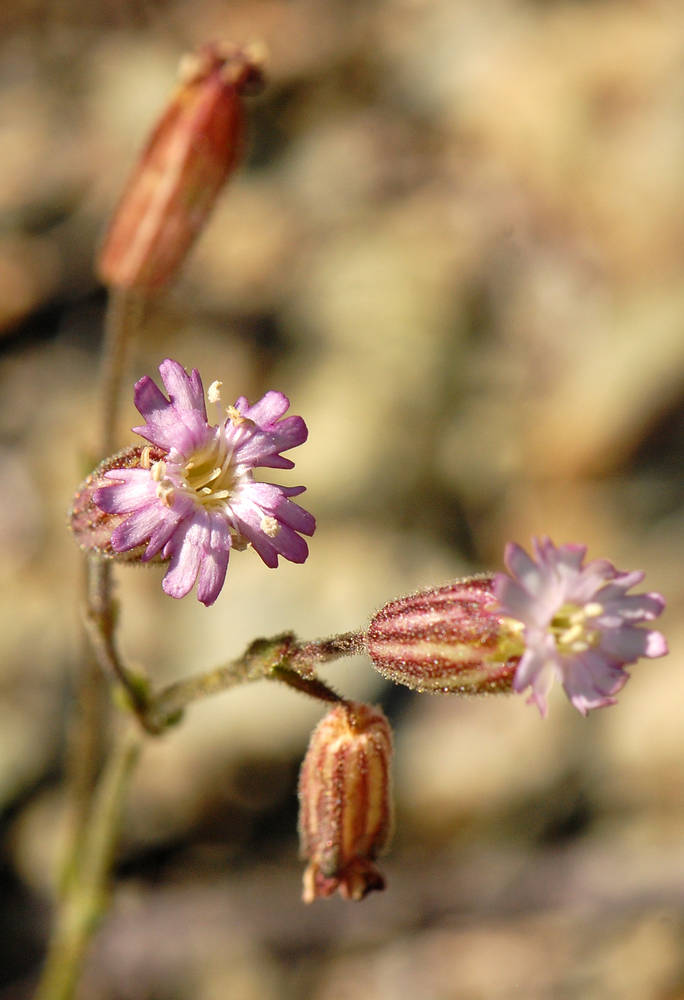Silene dioica
Silene grayi
red campion
Gray's catchfly
ascending, sometimes decumbent, 25–80 cm;
branches few;
hairs long-spreading below; ± glandular above.
decumbent to erect, 10–20(30) cm;
branches many, retrorsely puberulent below, glandular-viscid above.
basal spatulate, 3–8.5 cm × 10–35 mm; upper cauline ovate to elliptic, gradually reduced upward.
basal narrowly oblanceolate to spatulate, 1.5–4(6) cm × 1–5 mm, densely tufted; fleshy;
cauline linear to oblanceolate, 0.4–1 cm × 1–3 mm, abruptly reduced upward; upper leaves not overlapping pedicels.
terminal; open cymes, not 1-sided;
pedicels softly hairy; seldom glandular.
terminal; open cymes, not 1-sided, or flowers solitary;
pedicels glandular hairy.
unisexual, ascending to erect;
calyces narrowly (staminate) or broadly (pistillate) campanulate, inflated in fruit, 10–15 mm, softly hairy, 8–12-veined, not netted above; pale commissures absent;
lobes 2–3 mm, rounded to acute;
petal appendages 4;
limbs 8–12 mm, bright pink; entire or lobes 2, 1–2 mm;
stamens equaling petal claws;
styles 5, equaling petal claws.
bisexual; erect or sometimes nodding;
calyces broadly cylindric, enlarging and becoming campanulate in fruit, 8–10 mm, glandular-puberulent, prominently 10-veined, not netted above; pale commissures present;
lobes 1–2 mm, apiculate;
petal claws ciliate at base; appendages 2;
limbs 3–5 mm, pink to purplish;
lobes 4, 2 inner > outer;
stamens equaling petal claws;
styles 3(4), equaling petal claws.
broadly ovoid to globose;
teeth 5, splitting to 10;
stalks 0.
ovoid;
teeth 6(8);
stalks 1.5–3 mm.
1–1.6 mm, dark brown to black, not winged.
2–3 mm, brown, winged.
=24.
=48.
Silene dioica
Silene grayi
Roadside ditches, edge of woods. Flowering May–Jun. 0–200 m. Casc, Est, WV. ID, WA; scattered across northern US and southern Canada; Europe. Exotic.
McNeill (1979) noted that the earliest collection of S. dioica in the western United States was made in Portland in 1905. This species is sometimes cultivated, and it can escape from such settings. Silene dioica and S. latifolia are interfertile, and hybrid plants (S. ×hampeana) with pale pink petals can be expected.
Rocky, alpine slopes. Flowering Jun–Aug. 1000–2300 m. Sisk. CA, NV. Native.
Morton (2005) noted that small, alpine plants of S. parryi may be mistaken for S. grayi.
Rich Rabeler, Ronald Hartman
Rich Rabeler, Ronald Hartman
- Local floras:
BC,
OR,
WA
- Local Web sites:
Flora NW,
PNW Herbaria
WildflowerSearch
iNaturalist (observations)
USDA Plants Database
- LBJ Wildflower Center
- SEINet
- Plants of the World Online
- Encyclopedia of Life
- Wikipedia
- Google Image Search





